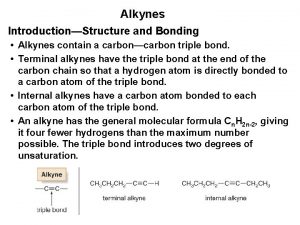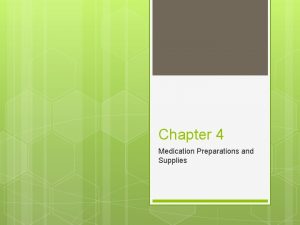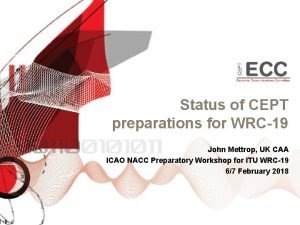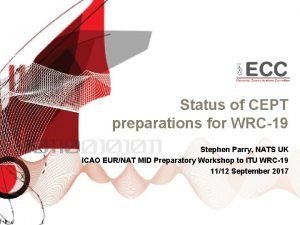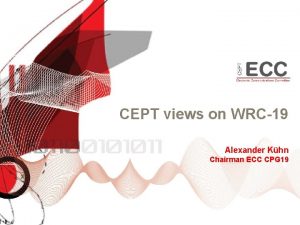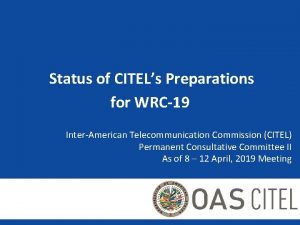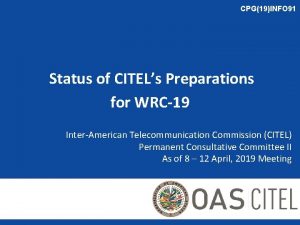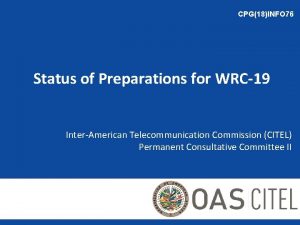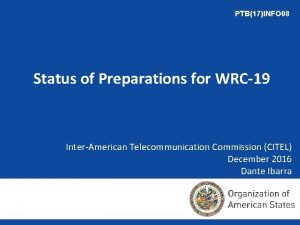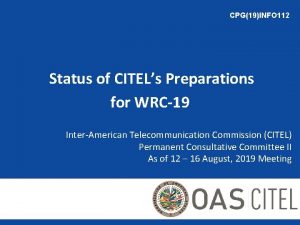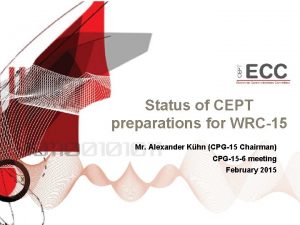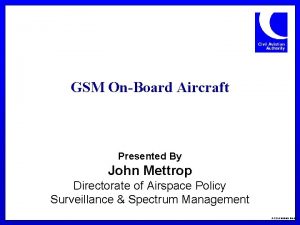Status of CEPT preparations for WRC19 John Mettrop



































- Slides: 35

Status of CEPT preparations for WRC-19 John Mettrop, UK CAA ICAO NACC Preparatory Workshop for ITU WRC-19 6/7 February 2018

Structure of CPG 19 • The Conference Preparatory Group (CPG 19) of CEPT/ECC is responsible for developing the ECPs and Briefs for WRC-19 and RA -19 • The CPG management team has been confirmed: • Chairman: Alexander Kühn, Germany • Vice-Chairmen: Gerlof Osinga, The Netherlands Alexandre Kholod, Switzerland • Secretary: Karsten Buckwitz, Germany

CPG 19 Project Teams

CPG 19 Deliverables • For both WRC-19 and the RA-19: • European Common Proposals (ECPs) • At least 10 administrations in support • No more than 6 opposing – as a general guideline • CEPT Briefs • Describe each agenda item • Contains the CEPT view – agreed by consensus at each stage • CEPT co-ordination in ITU-R meetings • Agreed contributions (also for non-WRC issues) • Co-ordination on lines to take

Agenda Item 1. 10 (approved by CPG 19#6) Issue: to consider spectrum needs and regulatory provisions for the introduction and use of the Global Aeronautical Distress and Safety System (GADSS), in accordance with Resolution 426 (WRC-15); Preliminary CEPT position: CEPT is of the view that: systems contributing to the GADSS shall operate in accordance with ICAO requirements or recommendations contained in Standard and Recommended Practices (SARPs), manuals or guidance material; any changes to the Radio Regulations should be determined on the basis of the GADSS concept developed by ICAO; systems identified to contribute to the GADSS do not require any change to Article 5 of the Radio Regulations; CEPT Coordinator: Jerome Andre

Agenda Item 1. 10 (approved by CPG 19#6) Preliminary CEPT position (continued): that according to the process to implement the GADSS concept an extension of activities towards WRC-23 may need to be considered [the list of the frequency bands and systems used by GADSS and also their technical and operational characteristics and operational parameters should be included in the corresponding ITU-R Recommendations; ] additional regulatory actions for the introduction and use of GADSS should not place any additional constraints on the existing and planned systems. CEPT Coordinator: Jerome Andre

Agenda Item 9. 1 Issue 9. 1. 4 (approved by CPG 19#6) Issue: to conduct studies to identify any required technical and operational measures, in relation to stations on board sub-orbital vehicles, that could assist in avoiding harmful interference between radiocommunication services; Preliminary CEPT position: CEPT is of the view that: • the ITU-R studies called for by Resolution 763 should be supported; • based on the results of those studies, what action is to be taken should be determined; • stations on board suborbital vehicles shall not cause harmful interference nor impose additional constraints on systems operating under the incumbent services. • suborbital vehicles need to be differentiated from current satellite launch vehicles.

Other agenda items Agenda items that may have an impact on spectrum used for aeronautical systems or services: (1. 7, 1. 8, 1. 9, 1. 11, 1. 12, 1. 13, 1. 14, 1. 16, 4, 8, 9. 1. 3, 9. 1. 6, 10)

Agenda Item 1. 7 (approved by CPG 19#5) Issue: to study the spectrum needs for telemetry, tracking and command in the space operation service for non-GSO satellites with short duration missions, to assess the suitability of existing allocations to the space operation service and, if necessary, to consider new allocations, in accordance with Resolution 659 (WRC-15); Preliminary CEPT position: CEPT supports additional allocations or upgrades of existing allocations to the space operation service for short duration mission satellites provided that: As far as current primary allocations to the space operation service in the space-to. Earth direction below 1 GHz are concerned, CEPT is of the view that: Studies of spectrum requirements are based on satellite missions planned and constellation development. Studies of spectrum requirements show the need for additional allocations or upgrades of existing allocations. Studies show compatibility with existing services. The band 137 -138 MHz could be a candidate band for short duration mission satellites, associated with relevant technical conditions (e. g. pfd limits). The bands 272 -273 MHz and 401 -402 MHz do not provide a solution to satisfy Agenda Item 1. 7. CEPT supports studies for possible modifications to the current regulatory situation including the removal of No 9. 21 in the existing allocations to the space operation service below 1 GHz in the Earth-to-space direction. Acting CEPT Coordinator: Mr Jaap Steenge (The

Agenda Item 1. 7 (approved by CPG 19#6) Preliminary CEPT position (continued): CEPT is of the view that sharing between non-GSO satellites with short duration missions and the mobile service in the frequency bands 150. 05 -174 MHz is not feasible in the Earth-to-space direction as well as the space-to-Earth direction. CEPT is of the view that consideration of the frequency band 154 -156 MHz as candidate for operation of non-GSO satellites with short duration missions is not feasible due to difficulties in sharing with the incumbent services (the radiolocation service). CEPT is of the view that sharing between non-GSO satellites with short duration missions and the radio astronomy service in the frequency bands 150. 05 -153 MHz and 406. 1 -410 MHz is not feasible in the Earth-to-space direction as well as the space-to. Earth direction. Acting CEPT Coordinator: Mr Jaap Steenge (The Netherlands)

Agenda Item 1. 7 (approved by CPG 19#6) Preliminary CEPT position (continued): CEPT recognises that studies with regard to the bands 399. 9 -400. 05 MHz and 401 -403 MHz, if any, will have to take into account the considerations under Agenda item 1. 2. In addition, CEPT is of the view that co-channel sharing between Earth-to-space links of non-GSO short duration missions and GSO Data Collection Systems is not feasible in the band 401 -403 MHz. Concerning space to earth direction CEPT is of the view that the frequency band 401 -403 MHz does not provide a solution to satisfy agenda item 1. 7. CEPT is of the view that any consideration of bands for use under this agenda item must exclude the 406 -406. 1 MHz COSPAS-SARSAT band as well as its adjacent 405. 9 -406 MHz and 406. 1 -406. 2 MHz bands (see resolves 1 of Resolution 205 (WRC-15)). Acting CEPT Coordinator: Mr Jaap Steenge (The Netherlands)

Agenda Item 1. 8 (approved by CPG 19#6) Issue: to consider possible regulatory actions to support Global Maritime Distress Safety Systems (GMDSS) modernization and to support the introduction of additional satellite systems into the GMDSS, in accordance with Resolution 359 (Rev. WRC-15); Preliminary CEPT position: Issue A: Modernisation of GMDSS • CEPT supports the introduction of the HF NAVDAT frequencies, defined in the Recommendation ITU-R M. 2058 -0, in RR Appendix 17. • CEPT opposes of the introduction of the HF NAVDAT frequencies, defined in the Recommendation ITU-R M. 2058 -0, in RR Appendix 15 for this WRC. • Issue B: Regulatory action due to the introduction of additional satellite systems into the GMDSS by IMO • CEPT supports regulatory actions to introduce an additional satellite system into the GMDSS as follows: • • the frequency band 1621. 35 -1626. 5 MHz used for GMDSS is allocated to the maritime mobile satellite service (for both space-to-Earth and Earth-to-space) on a primary basis Regulatory provisions are reinforced in order to ensure the protection of services operating in the frequency bands concerned and in adjacent frequency bands. CEPT Coordinator: Talayeh Hezareh (Germany)

Agenda Item 1. 9. 1 (approved by CPG 19#6) Issue: to consider, based on the results of ITU-R studies: regulatory actions within the frequency band 156 -162. 05 MHz for autonomous maritime radio devices to protect the GMDSS and automatic identifications system (AIS), in accordance with Resolution 362 (WRC-15); Preliminary CEPT position: • CEPT is of the view that the operation of autonomous maritime radio devices needs to be harmonized and regulated. • CEPT is of the view that the operation of autonomous maritime radio devices shall not reduce the integrity of AIS and of GMDSS. • CEPT supports the identification of spectrum for autonomous maritime radio devices within the frequency band 156 -162. 05 MHz. . CEPT Coordinator: Heinrich Peters (Germany)

Agenda Item 1. 9. 2 (approved by CPG 19#6) Issue: to consider possible regulatory actions, including spectrum allocations to the maritime mobile-satellite service (MMSS) Resolution 358 (WRC-12) to enable a new VHF data exchange system (VDES) satellite component in accordance with Resolution 360 (Rev. WRC-15); Preliminary CEPT position: CEPT supports sharing and compatibility studies between the proposed VDES satellite component (VDE-SAT) and the systems in the radiocommunication services allocated in the same and in adjacent frequency bands. CEPT is of the view that implementability of VDE-SAT and feasibility of its sharing and compatibility with the systems in the radiocommunication services allocated in the same and adjacent frequency bands without imposing any limitations on those services shall be confirmed by appropriate study results. CEPT Coordinator: Lars Løge

Agenda Item 1. 9. 2 (approved by CPG 19#6) Preliminary CEPT position (continued): CEPT supports the introduction of a new secondary maritime mobile-satellite (space-to. Earth) service allocation within the frequency bands 160. 9625 -161. 4875 MHz which is not channelized in RR Appendix 18 and the introduction of a new secondary maritime mobile-satellite (Earth-to-space) service allocation for the channels 24, 84, 25, 85, 26 and 86 of RR Appendix 18 using an appropriate pfd mask to protect incumbent services. With respect to the pfd-mask to be imposed on the VDE-SAT downlink, two views have been expressed. One view is based on the pfd-mask contained in Recommendation ITU-R M. 2092 -0, and one view is based on technical characteristics of land mobile service systems contained in Recommendation ITU-R M. 1808 CEPT Coordinator: Lars Løge

Agenda Item 1. 11 (approved by CPG 19#6) Issue: to take necessary actions, as appropriate, to facilitate global or regional harmonized frequency bands to support railway radiocommunication systems between train and trackside within existing mobile service allocations, in accordance with Resolution 236 (WRC-15); Preliminary CEPT position: CEPT is of the view that the harmonized use of frequencies for RSTT within existing mobile service allocations serves current and future demands of railway organisations on all operational levels. CEPT is of the view that no change to the RR is needed in response to WRC-19 Agenda item 1. 11, except suppression of Resolution 236 (WRC-15). *RSTT (railway radiocommunication systems between train and trackside systems) considered by CEPT: train radio, train positioning, train remote, train surveillance CEPT co-Coordinator: Zaza Gonjilashvili (Georgia) Dirk Schattschneider (Germany)

Agenda Item 1. 11 (approved by CPG 19#6) Issue: to take necessary actions, as appropriate, to facilitate global or regional harmonized frequency bands to support railway radiocommunication systems between train and trackside within existing mobile service allocations, in accordance with Resolution 236 (WRC-15); Preliminary CEPT position: CEPT is of the view that harmonisation of frequencies for RSTT can be achieved through the course of ITU-R study group work by an applicable ITU-R Recommendation and/or Reports (e. g. non-mandatory Recommendation ITU-R M. [RSTT_FRQ_HARMONISATION] containing regional harmonisation measures). In this regard, CEPT highlights its existing framework for RSTT train radio on the basis of GSM-R, which serves interoperable cross-border railway operations. CEPT recognizes that there are other standards/technologies and frequency bands providing for RSTT. In addition, CEPT is of the view that Agenda item 1. 11 does not cover the provision of public communication services for passengers . *RSTT (railway radiocommunication systems between train and trackside systems) considered by CEPT: train radio, train positioning, train remote, train surveillance CEPT co-Coordinator: Zaza Gonjilashvili (Georgia) Dirk Schattschneider (Germany)

Agenda Item 1. 12 (approved by CPG 19#6) Issue: to consider possible global or regional harmonized frequency bands, to the maximum extent possible, for the implementation of evolving Intelligent Transport Systems (ITS) under existing mobile-service allocations, in accordance with Resolution 237 (WRC-15); Preliminary CEPT position: CEPT is of the view that its existing regional harmonisation measures for ITS in the band 5 855 -5 925 MHz are sufficient and no changes to the RR are required in response to WRC-19 Agenda item 1. 12 except the suppression of Resolution 237 (WRC-15). CEPT is developing a revision of its existing harmonisation framework for ITS around 63 -64 GHz. CEPT is of the view that harmonisation measures for ITS at ITU-R level can be achieved through the course of ITU-R study group work by applicable ITU-R Recommendations (e. g. Recommendation ITU-R M. [ITS_FRQ]). CEPT co-Coordinators: Andrianilana Rakotondradalo (France) Tobias Vieracker (Germany)

Agenda Item 1. 12 (approved by CPG 19#6) Issue: to consider possible global or regional harmonized frequency bands, to the maximum extent possible, for the implementation of evolving Intelligent Transport Systems (ITS) under existing mobile-service allocations, in accordance with Resolution 237 (WRC-15); Preliminary CEPT position: CEPT is also of the view that harmonisation of ITS under AI 1. 12 is limited to the exchange of information to improve traffic management and to assist driving safety. In addition, CEPT is of the view that Road tolling (also known as Electronic Toll Collection (ETC)) in 5 795 5 815 MHz is not part of Agenda Item 1. 12. CEPT co-Coordinators: Andrianilana Rakotondradalo (France) Tobias Vieracker (Germany)

Agenda Item 1. 13 (approved by CPG 19#6) Issue: to consider identification of frequency bands for the future development of International Mobile Telecommunications (IMT), including possible additional allocations to the mobile service on a primary basis, in accordance with Resolution 238 (WRC-15); Preliminary CEPT position: CEPT supports the results of the ITU-R studies on IMT spectrum needs in the range 24. 2586 GHz. CEPT supports sharing and compatibility studies for the bands listed in Resolves 2 of Resolution 238 (24. 25 -27. 5 GHz, 31. 8 -33. 4 GHz, 37 -43. 5 GHz, 45. 5 -50. 2 GHz, 50. 4 -52. 6 GHz, 66 -76 GHz and 81 -86 GHz), with the focus on the frequency bands 24. 25 -27. 5 GHz, 40. 5 -43. 5 GHz and 66 -71 GHz. CEPT supports the identification of global bands for IMT among the bands listed in resolves to invite ITU R 2 of Resolution 238, taking into account the results of sharing and compatibility studies with existing services. Bands outside those listed in resolves to invite ITU-R 2 of Resolution 238 are not supported for consideration under this Agenda item. CEPT is in the process of harmonising the 24. 25 -27. 5 GHz band for Europe for 5 G before WRC-19 through the adoption of a harmonisation decision (ECC Decision (18)FF). CEPT is promoting the band for worldwide harmonisation by an IMT identification. Hence the 24. 25 -27. 5 GHz is a clear priority within CEPT studies have assumed an individual authorisation regime. Studies need to take into account the compatibility with and protection of all existing services, including their future deployments, in the same and adjacent frequency bands; in particular the protection of passive services from unwanted emissions of IMT-2020 equipment as well as current and future EESS/SRS earth stations should be addressed CEPT Coordinator: Robert Cooper (United Kingdom)

Agenda Item 1. 13 (approved by CPG 19#6) Preliminary CEPT position (continued): The following band s are not supported for the IMT identification: 31. 8 -33. 4 GHz “CEPT is of the view that, based on the results of the ITU-R compatibility studies between IMT and the radionavigation service in the 32 GHz band, this band shall not be identified for IMT”. 71 -76 GHz 81 -86 GHz. Note: CEPT has developed a Roadmap on 5 G (http: //cept. org/ecc/topics/spectrum-for-wirelessbroadband-5 g#roadmap). In this respect it is noted that “Europe has harmonised the 27. 5 -29. 5 GHz band for broadband satellite and is supportive of the worldwide use of this band for ESIM. This band is therefore not available for 5 G CEPT Coordinator: Robert Cooper (United Kingdom)

Agenda Item 1. 14 (approved at CPG 19#6) Issue: to consider, on the basis of ITU-R studies in accordance with Resolution 160 (WRC-15), appropriate regulatory actions for high-altitude platform stations (HAPS), within existing fixed-service allocations Preliminary CEPT position: CEPT supports, while ensuring protection of existing services and their future development including other applications of the fixed service and subject to the conclusions of the ongoing sharing and co-existence studies for the bands mentioned below and adjacent band scenarios: Worldwide identifications for transmissions from high altitude platform stations (downlink) in the bands 6 4406 520 MHz, 27. 9 -28. 2 GHz. Worldwide identifications for transmissions to high altitude platform stations (uplink and downlink) in the bands 31 -31. 3 GHz and 38 -39. 5 GHz CEPT Coordinator: Nasarat Ali (United Kingdom)

Agenda Item 1. 14 (approved at CPG 19#6) Preliminary CEPT position (continued): For the bands 6 440 -6 520 MHz, 27. 9 -28. 2 GHz, 31 -31. 3 GHz, 38 -39. 5 GHz, 47. 247. 5 GHz and 47. 9 -48. 2 GHz, CEPT is supporting new footnotes and associated resolutions and/or appropriate modifications to the existing footnotes and associated resolutions in order to facilitate the use of HAPS links on a global level and to protect incumbent services in these bands and, as appropriate, in the adjacent bands. CEPT is of the view that any consideration of the frequency band 24. 25 -27. 5 GHz in Region 2 under this Agenda item should not limit the possibility to identify the band for IMT on a global level under Agenda item 1. 13. CEPT Coordinator: Nasarat Ali (United Kingdom)

Agenda Item 1. 16 (approved by CPG 19#6) Issue: to consider issues related to wireless access systems, including radio local area networks (WAS/RLAN), in the frequency bands between 5 150 MHz and 5 925 MHz, and take the appropriate regulatory actions, including additional spectrum allocations to the mobile service, in accordance with Resolution 239 (WRC-15); Preliminary CEPT position: In the 5 150 -5 250 MHz band, CEPT notes that an outdoor relaxation to WAS/RLAN would affect the operation of the MSS feeder links, aeronautical radionavigation and aeronautical telemetry (see No. 5. 446 C). However, CEPT is still studying usage restrictions (e. g. in vehicle use) combined with appropriate mitigation techniques to achieve co-existence with incumbent services to enable outdoor WAS/RLAN use in this band. In the 5 250 -5 350 MHz band, CEPT notes that the current studies have shown difficulties in achieving co-existence with incumbent services and therefore supports no change to the RR in this band. CEPT Coordinator: Andrew Gowans (United Kingdom)

Agenda Item 1. 16 (approved by CPG 19#6) Preliminary CEPT position: In the 5 350 -5 470 MHz band, CEPT supports no change to the RR in this band. In the 5 725 -5 850 MHz band, CEPT would support a new mobile allocation to accommodate WAS/RLANs use if sharing and compatibility studies can demonstrate the effectiveness of any new proposed interference mitigation techniques to ensure the protection of radars, fixed service (see No. 5. 455) and FSS space station receivers. It is to be noted that CEPT will take into account compatibility studies between RLAN and specific applications within CEPT (e. g. road tolling systems). At this time, no effective mitigation techniques has been proposed to enable co-existence with certain modes of frequency hopping radars operated in this band in some CEPT countries. In the 5 850 -5 925 MHz band, CEPT notes that the current studies have shown difficulties in achieving co-existence with other incumbent services without imposing any additional constraints on existing services such as FSS (space station receivers) and existing applications under the mobile service such as ITS (including urban rail). Therefore, CEPT supports no change to the RR in this band. CEPT Coordinator: Andrew Gowans (United Kingdom)

Agenda Item 4 (approved at CPG 19#6) Issue: in accordance with Resolution 95 (Rev. WRC-07), to review the resolutions and recommendations of previous conferences with a view to their possible revision, replacement or abrogation; Preliminary CEPT position: CEPT encourages the constant review of Resolutions and Recommendations from previous conferences and will follow activities, in particular of ITU, associated with this effort. CEPT proposes to suppress Resolution RES 99 (WRC-15) CEPT proposes to modify Resolution TBD CEPT proposes to suppress Recommendation TBD CEPT proposes to modify Recommendation TBD CEPT Coordinator: Karel Antousek (Czech Republic)

Agenda Item 8 (approved by CPG 19#6) Issue: to consider and take appropriate action on requests from administrations to delete their country footnotes or to have their country name deleted from footnotes, if no longer required, taking into account Resolution 26 (Rev. WRC-07); Preliminary CEPT position: CEPT is of the view that there is no need to change the Resolution 26 (Rev. WRC-07). Issue A – Deletion of country footnotes or country names from footnotes CEPT supports Administrations taking the initiative to review their footnotes and to propose the deletion of their country names or the deletion of country footnotes, if no longer required. Issue B – Addition of country names into footnotes or new country footnotes CEPT is of the view that this agenda item is not intended for adding country names into footnotes and the addition of new country footnotes. CEPT is of the view that Conferences may continue to deal with requests to add country names to existing footnotes on a case by case basis, subject to the principle that proposals for the addition of country names to existing footnotes can be considered but their acceptance is subject to the express condition that there are no objections from the affected countries. Furthermore CEPT is of the view that proposals for the addition of new country footnotes which are not related to agenda items of this Conference should not be considered CEPT Coordinator: Dmytro Protsenko (Ukraine)

Agenda Item 9. 1 Issue 9. 1. 3 (approved by CPG 19#6) Issue: to study technical and operational issues and regulatory provisions for new nongeostationary-satellite orbit systems in the 3 700 -4 200 MHz, 4 500 -4 800 MHz, 5 925 -6 425 MHz and 6 725 -7 025 MHz frequency bands allocated to the fixed-satellite service; Preliminary CEPT position: CEPT supports no changes to the provisions of RR Article 21 and Article 22 in the frequency bands 3 700 - 4 200 MHz, 4 500 -4 800 MHz, 5 925 -6 425 MHz and 6 725 -7 025 MHz. CEPT is considering the introduction of a coordination procedure under RR No. 9. 12 in order to address coordination between non-GSO FSS systems in the frequency bands 3 700− 4 200 MHz and 5 925− 6 425 MHz. CEPT Coordinator: Ethan Lavan (France)

Agenda Item 9. 1 Issue 9. 1. 6 (approved by CPG 19#6) CEPT Coordinator: Fatih Yurdal (Turkey)

Agenda Item 10 Issue: to recommend to the Council items for inclusion in the agenda for the next WRC, and to give its views on the preliminary agenda for the subsequent conference and on possible agenda items for future conferences, in accordance with Article 7 of the Convention; PT-A has been tasked by CEPT #5 with the co-ordination of CEPTs position on Agenda item 10. The work will now begin. CEPT Coordinator: Pasi Toivonen (Finland) coordination team: Karsten Buckwitz (Germany), Wesley Milton (United Kingdom)

Next meetings CPG #7 will meet • 27 -30 November 2018, Hilversum, Netherlands its next project team meetings are: • • PTB #7: PTD #7: PTC #6: PTA #6: 11 -14 September 2018, Mainz, Germany 25 -28 September 2018, Kyiv, Ukraine 1 -18 October 2018, Shannon, Ireland 14 -18 January 2018, Copenhagen (ECO), Denmark CEPT looks forward to welcoming representatives from the other regional organisations to these meetings

Useful links: General information: http: //www. cept. org/ecc CPG page: http: //www. cept. org/ecc/groups/ecc/cpg Questions/Answers regarding CPG: https: //cept. org/files/4200/CPG%20 role%20 in%20 WRC%20 preparation%20 process%2011 oct 13. pdf Coordinators: http: //www. cept. org/ecc/groups/ecc/cpg/page/list-of-cept-coordinators-wrc-19/ CEPT Briefs/ECPs: http: //www. cept. org/ecc/groups/ecc/cpg/page/cept-briefs-and-ecps-for-wrc-19

Other Issues within CEPT Working Group – Frequency Management PT 51 Audio PMSE in the 960 -1164 MHz frequency band Video PMSE in the 2700 -2900 MHz frequency band CG Drones Spectrum requirements for drones Working Group – Spectrum Engineering PT 7 Audio PMSE in the 960 -1164 MHz frequency band PT 21 Receiver parameters in spectrum management PT 24 UWB vehicular access systems in 3. 4 -4. 8 GHz PT 40 Protection of aircraft from HIRF generated by satellite Earth stations

Thank you

Abbreviations AIS CEPT CG CPG ECC ECP ECO EESS ESIM ETC EV FSS GADSS GMDSS GSO GSM-R HAPs HIRF Automatic independent surveillance European conference of postal and telecommunications administrations Co-ordination group Conference preparatory group Electronic communication committee European common proposals European Communication Office Earth exploration satellite system Earth station in motion electronic toll collection Electric vehicles Fixed satellite service Global aeronautical distress and safety system Global maritime distress and safety system Geo-stationary orbit Global system for mobile communications – railway High altitude platforms High intensity radiated field ICAO IMT ITS ITU MMSS NAVDAT NGSO PMSE PT RLANs RR RSTT SAR VDES WAS WPT WRC International Civil Aviation Organization International Maritime Organization International mobile telecommunications Intelligent transport systems International Telecommunication Union Maritime mobile satellite service Mobile satellite service Navigational data Non geo-stationary orbit Programme making and special events Project team Radio local area networks Radio regulations Railway radiocommunication systems between train and trackside systems Search and rescue VHF data exchange system Wireless access systems Wireless power transfer World radiocommunication conference
 Compounding sterile preparations quiz
Compounding sterile preparations quiz Iv admixture definition
Iv admixture definition Strengthening or concentration preparations can be made by:
Strengthening or concentration preparations can be made by: Monophasic example
Monophasic example Preparation food meaning
Preparation food meaning Preparations of alkynes
Preparations of alkynes The cask of amontillado what is fortunato's weak point
The cask of amontillado what is fortunato's weak point Why did montresor make sure fortunato is drunk
Why did montresor make sure fortunato is drunk Sterile semisolid preparations for ophthalmic use only are
Sterile semisolid preparations for ophthalmic use only are Fspos vägledning för kontinuitetshantering
Fspos vägledning för kontinuitetshantering Typiska drag för en novell
Typiska drag för en novell Tack för att ni lyssnade bild
Tack för att ni lyssnade bild Returpilarna
Returpilarna Varför kallas perioden 1918-1939 för mellankrigstiden?
Varför kallas perioden 1918-1939 för mellankrigstiden? En lathund för arbete med kontinuitetshantering
En lathund för arbete med kontinuitetshantering Underlag för särskild löneskatt på pensionskostnader
Underlag för särskild löneskatt på pensionskostnader Tidbok för yrkesförare
Tidbok för yrkesförare Sura för anatom
Sura för anatom Vad är densitet
Vad är densitet Datorkunskap för nybörjare
Datorkunskap för nybörjare Boverket ka
Boverket ka Tes debattartikel
Tes debattartikel För och nackdelar med firo
För och nackdelar med firo Nyckelkompetenser för livslångt lärande
Nyckelkompetenser för livslångt lärande Påbyggnader för flakfordon
Påbyggnader för flakfordon Formel för lufttryck
Formel för lufttryck Svenskt ramverk för digital samverkan
Svenskt ramverk för digital samverkan Kyssande vind analys
Kyssande vind analys Presentera för publik crossboss
Presentera för publik crossboss Vad är ett minoritetsspråk
Vad är ett minoritetsspråk Kanaans land
Kanaans land Treserva lathund
Treserva lathund Fimbrietratt
Fimbrietratt Bästa kameran för astrofoto
Bästa kameran för astrofoto Centrum för kunskap och säkerhet
Centrum för kunskap och säkerhet Lågenergihus nyproduktion
Lågenergihus nyproduktion





